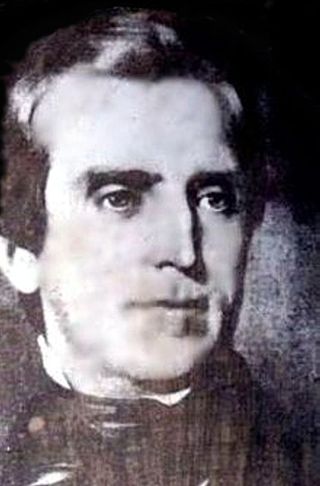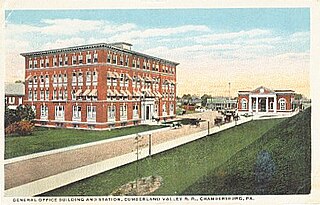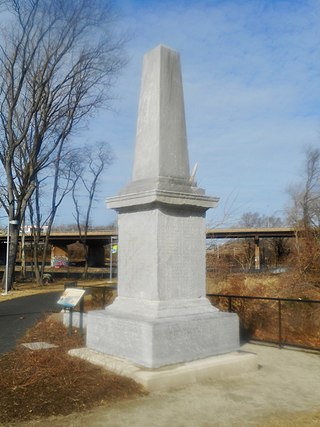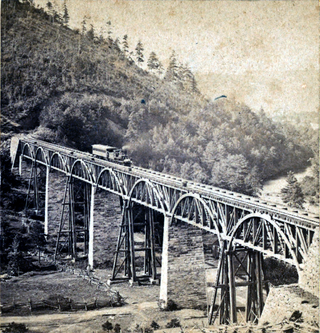
The Baltimore and Ohio Railroad was the first common carrier railroad and the oldest railroad in the United States. It operated as B&O from 1830 until 1987, when it was merged into the Chessie System; its lines are today controlled by CSX Transportation.

Frank Heyling Furness was an American architect of the Victorian era. He designed more than 600 buildings, most in the Philadelphia area, and is remembered for his diverse, muscular, often inordinately scaled buildings, and for his influence on the Chicago-based architect Louis Sullivan. Furness also received a Medal of Honor for bravery during the Civil War.
The Pennsylvania Railroad, legal name The Pennsylvania Railroad Company, also known as the "Pennsy", was an American Class I railroad that was established in 1846 and headquartered in Philadelphia. It was named for the commonwealth in which it was established. At its peak in 1882, the Pennsylvania Railroad was the largest railroad, the largest transportation enterprise, and the largest corporation in the world.

The Reading Company was a Philadelphia-headquartered railroad that provided passenger and freight transport in eastern Pennsylvania and neighboring states from 1924 until its acquisition by Conrail in 1976.

George Washington Whistler was a prominent American civil engineer best known for building steam locomotives and railroads. He is credited with introducing the steam whistle to American locomotives.

Moncure Robinson was an American civil engineer and railroad executive. He was one of the leading engineers for railroad survey and construction projects from the 1820s to the 1840s. He conducted surveys for and constructed multiple railroad lines including the Danville and Pottsville Railroad, the Allegheny Portage Railroad, the Chesterfield Railroad, the Petersburg Railroad, the Richmond and Petersburg Railroad, the Richmond, Fredericksburg and Potomac Railroad, the Winchester and Potomac Railroad, the Raleigh and Gaston Railroad, and the Philadelphia & Reading Railroad.

The Philadelphia, Wilmington and Baltimore Railroad (PW&B) was an American railroad that operated independently from 1836 to 1881. Headquartered in Philadelphia, it was greatly enlarged in 1838 by the merger of four state-chartered railroads in three Mid-Atlantic states to create a single line between Philadelphia and Baltimore.

The Strasburg Rail Road is a heritage railroad and the oldest continuously operating standard-gauge railroad in the western hemisphere, as well as the oldest public utility in the Commonwealth of Pennsylvania. Chartered in 1832, the Strasburg Rail Road Company is today a heritage railroad offering excursion trains hauled by steam locomotives on 4.02 mi (6.47 km) of track in Pennsylvania Dutch Country, as well as providing contract railroad mechanical services, and freight service to area shippers. The railroad's headquarters are outside Strasburg, Pennsylvania.

The President Street Station in Baltimore, Maryland, is a former train station and railroad terminal. Built in 1849 and opened in February 1850, the station saw some of the earliest bloodshed of the American Civil War (1861-1865), and was an important rail link during the conflict. It is the oldest surviving big-city railroad terminal in the United States.

The Cumberland Valley Railroad was an early railroad in Pennsylvania, United States, originally chartered in 1831 to connect with Pennsylvania's Main Line of Public Works. Freight and passenger service in the Cumberland Valley in south central Pennsylvania from near Harrisburg to Chambersburg began in 1837, with service later extended to Hagerstown, Maryland, and then extending into the Shenandoah Valley to Winchester, Virginia. It employed up to 1,800 workers.
The National Railway Historical Society (NRHS) is a non-profit organization established in 1935 in the United States to promote interest in, and appreciation for the historical development of railroads. It is headquartered in Philadelphia, Pennsylvania, and organized into 16 regions and 170 local chapters located in the United States, Canada, and the United Kingdom. The NRHS sponsors the popular RailCamp summer orientation program in partnership with Amtrak and the National Park Service, offering high school youth hands-on experience in the railroad industry.

The Newkirk Viaduct Monument is a 15-foot (4.6 m) white marble obelisk in the West Philadelphia neighborhood of Philadelphia, Pennsylvania. It was installed in 1839 to mark the completion of the Newkirk Viaduct, the first permanent railroad bridge over the Schuylkill River. It is inscribed with the names of 51 railroad builders and executives, among other information.

The Catawissa Railroad was a railroad that operated in Pennsylvania between 1860 and 1953. For most of its lifespan it was leased by the Reading Company, and was subsequently merged into the Reading.

Matthew Newkirk was an American businessman, railroad magnate, banker and philanthropist. He was president of the Philadelphia, Wilmington and Baltimore Railroad (PW&B) and led the integration of four railroad companies to establish the first direct rail service between Philadelphia and Baltimore. He was a director of the Second Bank of the United States; and an investor in the Little Schuylkill Navigation, Railroad and Coal Company and the Cambria Iron Company.
Mahlon Betts (1795–1867) was an American carpenter, railroad car builder, shipwright, businessman, banker, and legislator who helped found three of Wilmington, Delaware's major manufacturing enterprises: the Harlan and Hollingsworth Company, the Pusey and Jones Company, and the Betts Machine Company.
Edward Tatnall (1782–1856) was an American miller and railroad executive based in Wilmington, Delaware.

Samuel Jaudon was a 19th-century American banker and businessman who was best known for his work as cashier and agent of the Bank of the United States from 1832 to 1837. During the Panic of 1837, Jaudon secured large loans for the bank and engaged in commodity speculation, particularly cotton, which failed to secure the bank's own credit and caused it to go bankrupt.
Henry Roe Campbell was an American surveyor and civil engineer. Campbell contributed to American railroading and bridge-building in the first half of the 19th century. Campbell patented his 4-4-0 design in February 1836, just a few months before the patent law was changed to require that claims include proof of originality or novelty.